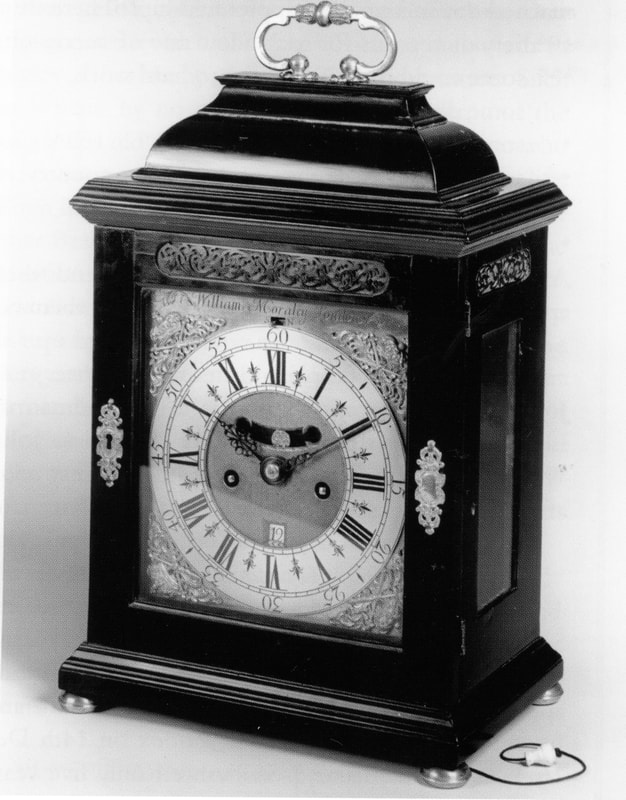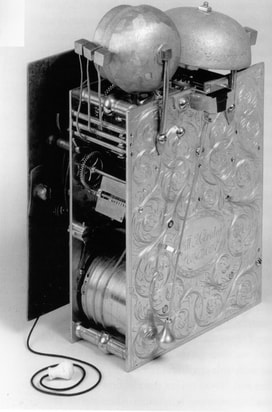|
Thomas Tompion had set up his workshop in Water Lane, off Fleet Street, in early 1671 at the age of 32. Very little is known about his earlier life and his training, apart from the fact that he would have been trained by his father as a blacksmith at a very young age. By 1674 his work was well known and sought after. Robert Hooke had his quadrant made by Tompion which he found was of the finest quality, so was able to recommend him to some of his wealthy acquaintances which included King Charles ll. Tompion was able to gather a large number of skilled craftsmen around him and often bought in other clockmakers work in order to satisfy the great demand for his work. The rules of the Clockmakers’ Company were very limiting to ordinary freemen but those of higher order and the more skilled artisans like Tompion and Quare were able to flaunt the rules and employ more workers in their workshops than the rules would allow, if they paid for them. Tompion appears to have found a way round the rules by employing a number of out-workers who were not housed on his premises but worked independently from their own premises but supplied the Tompion workshop with ready-made clocks and watches. William Moraley was one of these skilled craftsmen who supplied clocks and watches to the Tompion workshop. William Moraley was the youngest son of Ridley, yeoman of Latterford, Simonburn, Nbd., born about 1666 and apprenticed on 8 Feb 1680/1 through Henry Child to Philip Corderoy for 7 years. In 1687 he was turned over to Thomas Tompion and freed by the C.C. in Dec 1688. It must have been then that he set up his own workshop in Greyfriars, Newgate. He was living there when he married Martha Mason, daughter of John Mason, a founder, by special licence on 24 Nov 1697. The witness was Solomon Bouquet, a fellow clockmaker living in the same parish who probably also worked for Tompion. Martha Mason was a direct descendant of King Edward lll, down the female line and through her family connections William would have a ready market for his clocks and watches. William and his family did mix with the London upper class, as William junior later recounts in his book written in 1743.
Both hands are ornately pierced. The ebonised case has brass mounted escutcheons, carved, pierced frets and caddy top and pull repeat cord under the case.
On 27th July 1723 Deodatus Threlkeld, the leading watchmaker in Newcastle, announced his retirement to his house in the country in the Newcastle Courant. Less than a month later on 24th Aug 1723 William Moraley announced his arrival in the Town with the following advertisement in the same newspaper :-“ William Moraley, Clock and Watch Maker, who served his Time with, and wrought for the famous Mr. Tompion at London, till his Decease, is lately come into his Native Country and designs to reside in Newcastle upon Tine, who makes and sells Gold and Silver Watches, mends and cleans all Sorts of Clocks or watches; and is to be met with at John Morley’s House, next Door to the Black and Grey, in the Big-market, Newcastle.”
Here William tells us that he was apprenticed to Thomas Tompion and worked for him until the latter’s death and had set up a workshop at his brother’s house in the Bigg Market. Some writers have suggested that Moraley and his son William, both worked for George Graham after Tompions death. If that was true, why was William junior unable to find work in London when he went back there in 1728 and was declared bankrupt in 1729? William junior had been bound by his father about 1716 but never took his freedom of the C.C. The two men had worked together successfully for about two years in Newcastle before William senior died in 1725 without leaving his son any inheritance, only his watchmaking tools, William junior was unable to continue the business himself. Tompion employed some of his former apprentices as out-workers after they had set up their own workshops. Ben Harris was one of those outworkers who had been apprenticed to John Dyde in the B.C. about 1670 and turned over to Tompion in 1677 and freed by the B.C. in 1679. Harris also had an apprentice Joseph Audley, bound in 1680 and turned over to Tompion in 1683. The Dyde cousins, Thomas of Exchange Alley and John were watchmakers in the B.C., probably both worked for Tompion as out-workers too, they both had apprentices turned over to him. Thomas Dyde’s apprentice, Charles Murry was turned over to Tompion in 1687. Jeremy Evans in his book about Tompion suggests that Charles Murry made clocks the same as those of the Tompion workshop. In 1695 officially, Tompion declared he had 14 apprentices but when Constantyn Huygens (brother of Christian) visited Tompion in 1690 he said there were 20 apprentices working for Tompion, but he may have included journeymen and Ambrose Gardner’s apprentices (Evans). In 1676 Tompion had moved into larger premises on the corner of Water Lane and Fleet Street to accommodate his growing workforce and Ambrose Gardner of the Goldsmiths’ Company moved into the new premises in 1688, with his apprentices. He was presumably, engraving the clocks and watches, as well as making watch cases for the Tompion business. Meanwhile John Gray, a clockmaker, had moved into Tompion’s old premises in Water Lane and later he was joined by Thomas White junior. William Baldwin was in the premises by 1692. All three clockmakers were freemen of the B.C. who were all presumably working for Tompion. Even during the recession of the 1690s the Tompion workshop was busy turning out many clocks and watches. However, at the same time the C.C. were looking for ways of reducing the numbers of clock and watchmakers working in the City, because of the recession, which is when a number of the London craftsmen had to find work in other parts of the country; this flow of clockmakers to the provinces continued well into the 18th century. There's a wealth of information about many of the Clock and watchmakers who were in the Blacksmiths' Company and their apprentices, in my book "Early Clock and Watchmakers in the Blacksmiths' Company" which you can buy online here. If you are interested in Clockmakers who were working in the North East of England you may find it interesting to read my book "Clockmakers of Northumberland and Durham" which you can buy online here.
0 Comments
|
AuthorKeith Bates is an amateur horologist who has been researching clocks, watches and chronometers and their makers for over 30 years. Archives
August 2023
Categories
All
|



 RSS Feed
RSS Feed